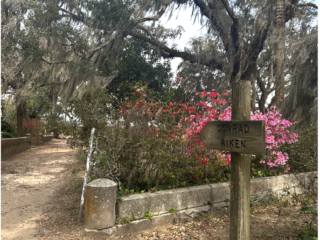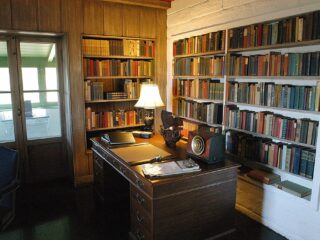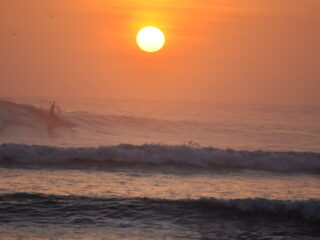Called the “Poet of the Sierras” and the “Byron of the Rockies,” Cincinnatus Hiner Miller alias Joaquin Miller was also termed a “poseur” and a “farce” during his careers as a 19th century lawyer, judge, pony express rider, newspaperman, teacher, cook, miner, conservationist and poet.
Taking poetic license to heart, Miller was inventive about every aspect of his life including his name, age, and where he was born. However, 25 years after his death, his secret “California Diary” was unearthed, revealing that many of his unusual experiences were products of his lively imagination. Fellow litterateur, Ambrose Bierce, called him “The greatest liar this country has ever produced.” Miller, though, always explained: “I’m not a liar. I simply exaggerate the truth.”
Claiming to be born in “a covered wagon pointed west,” Miller was actually born near Liberty, Indiana in September 1837. He was named after the city of Cincinnati and not the Roman statesman. His middle name, which he often changed to Heine to gain a “poetic association” with the famed German poet, came from the doctor who delivered him. And from his early thirties on, he was always five years younger than his real age, a chronological change he made to improve both his poetic and sex image.
Miller’s father, Hulings, kept the family going west as he took turns not supporting it as a teacher, farmer and merchant. Finally, the family wound up migrating to Oregon in 1852. A restless boy, “Nat”, as he was called, he ran away to the California gold fields when he was 17 and stayed for several years. During this period, Miller always maintained he was wounded by an arrow at the Battle of Castle Crags, though none of the combatants remembered his presence, bleeding or otherwise. For the rest of his life, Miller attributed various ailments to assorted Indian battles, though his tales tended to change with different audiences and he would occasionally limp with the wrong foot. Imitating his hero, Lord Byron, may have been another explanation for the limp.
At the mine camps, Miller worked as a cook, among other tasks, for $50 a month. As a result of eating his own food, he caught scurvy. He also developed a taste for whiskey, with a preference for 110% proof. Because he wrote poetry in the kitchen, he was known in the settlement as “Crazy Miller.” In his defense, he wrote: “I cooked all winter for 27 men and every man was alive in the spring.”
Miller turned down enlisting in a filibuster expedition to Nicaragua, though he later claimed he fought in the Central American country. Finally, he was forced to leave the camp when he wrote unflattering poetry about a partner. The partner took to his guns, as Miller took to the road.
Deciding to become “native” and live with the Indians, Miller, according to one story, lost his virginity to paid Indian girls out in the fields. It is certain that he became a “squaw man,” siring a daughter with his Indian paramour, Paquita. The child was called Cali-Shasta, which means lily of Shasta. Paquita and other tribeswomen called Miller “Bo-Bo”, which alluded to his foolish qualities.
Tiring of this life, Miller deserted Paquita and their daughter and returned to the family hearth in Oregon. He became a college graduate in a record time, three months, taking classes at newly-founded Columbia College in Eugene. He managed to become his class valedictorian before the school burned down. Because the records were destroyed, no one is quite sure what Miller studied.
Returning to California with his degree, Miller rejoined his Indian friends in Shasta County. One of his fondest claims was that he was instrumental in trying to foment an independent, Indian utopia to be called the “Shasta Republic.” But what appears to have happened is that he managed to get embroiled with the law twice. First, he was accused of being a renegade and fighting alongside and not against the Indians. The second offense came when he made off with a horse or two, after he wasn’t paid for his work as a cowhand.
Horse thieves were generally hung in those days, which prompted Miller to escape quickly. As usual, there is conflicting testimony on how this was done. Miller said Paquita slipped him a saw, but others state that his jail mate engineered his breakout. The fledgling poet also claimed that Paquita died heroically in saving him, but she, perhaps not understanding what it took to be a poet, lived for another fifty years.
Regardless, Miller returned again to Oregon where his lack of legal education and official status as a fugitive didn’t stop him from becoming a lawyer. When his law practice didn’t flourish, he taught school and then became a pony express rider. Meanwhile, he kept writing poems. After reading the verse of one his poems, Minnie Myrtle, also known as the “Sweet Singer of the Coquille” and by her real name of Theresa Dyer, took off with Miller on a whirlwind courtship and the two were married in September of 1862.
He used his profits from his pony express days to buy into the Eugene City Democratic Register. In return for his investment, he was allowed to write editorials and poems. While no relationship to this literary outpouring has been established, the weekly ended after 29 issues.
After a brief and unsuccessful attempt to crack the literary set in San Francisco, the writing pair came back to Oregon. Miller practiced law again and got elected a judge on the Democratic ticket. He insisted at times upon reading his poetry out loud from the bench, which annoyed both the defense and prosecution. He also spent a good deal of time in “doggeries,” which is what saloons were called then. Needless to say, he wasn’t reelected as a judge. Tiring of his antics, Minnie left him. As with every other aspect of Miller’s life, this situation is also confusing. Minnie claimed they had three children, while Miller only acknowledged two.
Forsaking law for a literary career Miller decamped in 1870 for San Francisco where he became friends with Ina Coolbrith, a poetess. She forced him to rewrite more of his poetry (a practice he generally disdained) and convinced him he would never succeed as a poet with a name like Cincinnatus. Accordingly, he called himself Joaquin after Joaquin Murieta, the infamous Mexican bandit.
Believing that real recognition awaited him in London, he left for the English capital after having cards printed that read “Joaquin Miller, Byron of the Rockies.” He also brought with him laurel leaves from Sausalito for a wreath to put on Byron’s tomb.
After visiting the requisite graves in England, Miller finally got a book of verse, “Pacific Poems,” printed by a vanity publisher. The slim opus netted mild praise and any dinner invitations. He took to wearing such outfits as a sombrero, flaming red shirt, blue polka dot bandana, high-heeled boots, and a riding quirt. Limping around London as the consummate Westerner, he got so excited by his own poetry, he wound up once on the floor biting the ankles of distaff aristocrats. But he knew what he was doing, later declaring: “It helps sell the poems, boys, and it tickles the duchesses.”
Basically, the British appreciated the man more than his poetry, whereas American critics ignored the man and derided the verse as overly romantic and not particularly literate. Miller admitted, “I’m damned if I could tell the difference between a hexameter and pentameter to save my scalp.”
Flushed with success, Miller returned to the U.S. Back in San Francisco, he was hailed as “California’s Own” (he called California a “Grander Greece”) and as a man who put one over on the English. Branching out into novels and other narratives, Miller discovered the reviews weren’t quite as good on this side of the Atlantic. “Life Among The Modocs,” which Miller and a ghostwriter put together as an autobiography and which has been indexed by libraries as fiction, the California Mail Bag opined: “We fear Mr. Miller lacks the power of growth, unless it is the power to grow worse.”
Undaunted, Miller kept writing (two of his pseudonyms (right word?) were Agricola and Professor Bones) though he was reputed to have one of the world’s worst handwritings. He attributed his faulty calligraphy to a poisoned arrow that pieced his right wrist during his heroics in the Indian battles. Articles dispatched from Europe for the San Francisco newspapers were never printed as the editors couldn’t decipher his scratchings. He was once asked to reply either with a cross or circle, and even then no one was able to make out either mark.
As an advocate of true love, he began a 30-year affair with a Mrs. Frank Leslie, wife of a publisher of weekly magazines, who was also known as Mrs. Bluebeard for her various husbands and lovers. Living in New York, he married a young heiress, naively lost money in the stock market, and wrote a muckraking novel before muckrakers received their name. Early in 1886, seeking the source of his early inspiration, he returned West as associate editor of Golden Era in San Francisco.
Wanting to be close to nature, he bought land above Oakland and kept buying until he had some 70 acres. He called his retreat “The Hights,” insisting on his own distinctive spelling. A tree lover, he kept planting eucalyptus, pine and acacia until he had a private forest. Miller also erected his own funeral pyre besides memorials for other luminaries including a stone tower for poet Robert Browning. Because he enjoyed writing when it rained, he had special pipes put on the roof to help his muse. For his more naive visitors he would spout various incantations and pretend to produce these local rainfalls through his Modoc medicine man powers. When the magazine folded he went on lecture tours, singing hymns in what he claimed was an obscure Indian tongue no other white man had ever mastered.
Among his various soulmates, on this aerie, was a 16-year old girl and assorted actresses, one of whom tried to blackmail him. The press, meanwhile, dubbed him “Poet Lothario.” An ardent conservationist, he served as an official delegate from California to the National Forestry Councils. He recommended seedlings to be planted at the Presidio in San Francisco and on Goat Island. There was a movement to name this island after Miller but he demurred, saying: “I might commit some overt act that would disgrace the island.”
Intrigued by the second “Gold Rush” in his lifetime, he went to the Klondike as a correspondent for the Hearst newspapers, and was said to have written some of his articles before reaching his destination. However, in Alaska he did lose part of a toe and an ear from frostbite.
Finally slowing down, Miller died in February 1913. He had directed that preachers of every denomination officiate at his funeral, but had to settle for an Unitarian who called him “the last of America’s great poets.” The San Francisco Call” rated his poem “Columbus” equal to the “Gettysburg Address” and better than Ralph Waldo Emerson’s “Concord Hymn.” Today, however, Miller’s poems and books are hardly known. Somehow befitting the strange course of his life, his funeral got out of hand and a mob ransacked “The Hights” for souvenirs and the police had to “rescue” his corpse.
If you visit
Miller’s main memorial in California (there are some in Oregon) is at Joaquin Miller Park above Oakland. The road to the park is also named after him. His estate, “The Hights,” was sold by his family in 1919 to the City of Oakland for $33,0000. Some of his buildings were destroyed by a fire in 1933. Miller’s home, “The Abbey,” is open to visitors. The center of the park is the Woodminster Amphitheater used for performances. There are also hiking trails, community kitchens, and picnic groundsspread around the multitude of trees Miller planted.
During the period Miller and his first wife visited San Francisco they lived at 421 Fulton Street.








